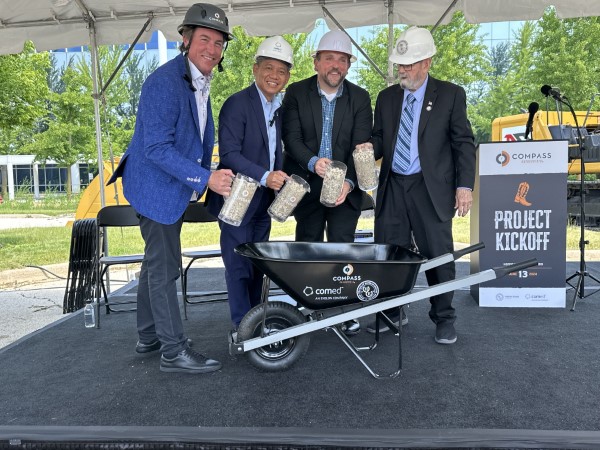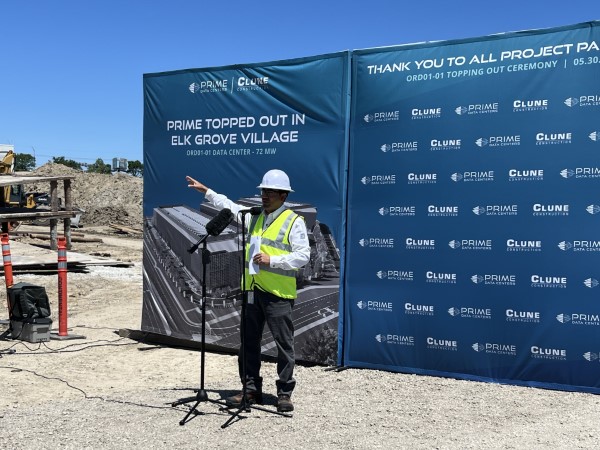Illinois ranks as a global top five data center market that gains market share each year. The numbers behind the surge reveal who’s investing in Illinois and where the dollars go.
A recent Newmark U.S. Data Center Market Overview shows that “Chicago remains an attractive market for hyperscalers like Microsoft and Meta, as well as other firms, due to its connectivity at the center of the country, power infrastructure and large talent pool. Major industries driving demand include technology, finance and health care. Overall, data center inventory has expanded 35% from 2019 measures, yet availability remains under 2%.”
Numbers like that drive growth. With a total market size of approximately 1GW and an availability rate of just 1.6%, Chicagoland is getting looks from more national developers and end-users. Newmark projects supply growth of 300 MW by 2027.
Another factor driving growth is cost, and on that measure, Chicago remains a bargain. CBRE reports that Chicago still has the lowest rental rates of all major global markets at US$155 to $165 per month for a 250-to-500-kW requirement.
Costs and supply were big factors behind Dallas-based Compass Datacenters’ recent purchase of Sears’ 2.4 million-sq.-ft. headquarters campus. Compass plans to raze the campus to make room for data centers.
On June 13, ComEd teamed up with Compass to kick off the project at the old Sears site in Hoffman Estates. Upon completion, the project will be one of the largest-ever data center campuses in Illinois. The $10 billion investment represents one of the largest corporate facility projects in state history.
“We’re taking a careful and methodical approach to demolition, setting the stage for doing what we do best — building sustainably and building to last,” said Compass CEO Chris Crosby. “We appreciate the opportunity to help build Illinois’ digital infrastructure and serve the state for years to come.”
ComEd will deliver a new substation to the site by mid-2026 to power the 200-acre campus. Around 1,000 construction jobs will be created during the buildout.
Compass has company. On May 3, Atlanta-based T5 Data Centers announced it will build a 480-MW data center campus in Grayslake. The 160-acre site will be operational by 2027 and house multiple data center facilities about 40 miles north of Chicago.
“The new Grayslake campus represents a major investment by T5 to meet the growing demand for large-scale data center capacity to support cloud and artificial intelligence workloads,” said David Horowitz, senior vice president and head of leasing for T5. “The site’s location is perfectly positioned between major data center hubs of the northern Chicago suburbs and southeastern Wisconsin, which provides an ideal connection point. The Chicago land market continues to be one of the premier markets to build and operate data centers because of the attractive tax incentives, labor pool, established connectivity, and power availability.”
Where Chicago Ranks Globally
According to Intersect Illinois, Chicago is tied with Dallas as the third-largest data center hub in the U.S. with 4.8 million sq. ft. Another 2.2 million sq. ft. of construction is in the pipeline. Earlier this year, Cushman & Wakefield reported that Chicago is the fourth largest data center market in the world.
Incentives help. Illinois passed a major data center incentive program bill in 2019. The legislation provides exemptions from state and local sales taxes on projects that invest at least $250 million and create at least 20 new jobs over a five-year period. These projects may also be eligible for an additional tax credit equal to 20% of the wages paid to construction workers who build these facilities in certain qualifying zones.
After Gov. JB Pritzker signed this legislation, Illinois landed 15 data center projects investing more than $4.6 billion into new facilities in the state.
“It is a power-first strategy. I have never seen the magnitude of projects that we have now. We are seeing 600MW to 1.4GW projects; and the land requirements are larger too. It is an open arms race.”
— Ed Sitar, Senior Manager of Economic Development, ComEd
In fact, yet another one was announced March 26 when DPK Hillside proposed building a two-story, 245,000-sq.-ft. data center at 101 North Wolf Road in the Hillside area of Chicago. The 13-acre project will take two years to build and target hyperscale customers, DPK said.
Andy Cvengros, managing director of brokerage for JLL, says these projects are not an anomaly.
 Prime Data Centers’ topping out ceremony in Elk Grove Village.
Prime Data Centers’ topping out ceremony in Elk Grove Village.
Photo courtesy of ComEd
“CloudHQ is investing $2.5 billion to build 1.5 million square feet at the old United Airlines HQ in Mount Prospect. Prime Data Centers signed a lease for 175 MW and is spending $1 billion at Elk Grove Village. Stream Data Centers bought 52 homes and tore them down to build data centers. Hoffman Estates, Aurora, Elk Grove and Franklin are all growing as data center markets around Chicago,” he says. “The suburbs are going crazy right now. Downtown Chicago sites are just too small. As demand increases, more movement will be seen out west. Elgin and others will get more looks.”
“Everything is being considered. They are looking at power plants and drawing a circle around them. It is 100% a race.”
— Andy Cvengros, Managing Director of Brokerage, JLL
As Chicagoland becomes saturated, says Cvengros, developers will look to build in Joliet and other markets south of Chicago. “A substantial amount of power is already there,” he says. “People are looking at the area around Rivian in Normal. Everything is being considered. They are looking at power plants and drawing a circle around them. It is 100% a race. If you find the property and the available power, data centers require a load study. Those studies take six to eight months and cost $200,000. Where the rubber meets the road is the end-user pushing the deal.”
‘It Is an Open Arms Race’
Ed Sitar, senior manager of economic development for ComEd, the state’s largest electric utility, says, “It is a power-first strategy. I have never seen the magnitude of projects that we have now. We are seeing 600-MW to 1.4-GW projects; and the land requirements are larger too. It is an open arms race. Everybody wants to be the first to deploy their servers and be operational for AI hyperscale cloud computing.”
Sitar calls these investments “transformative” for Illinois. “They are wins at the local and state level,” he says. “They pay a lot of taxes, but they do not bring in a lot of people.”
The typical site search in Illinois today begins with a request to find 100 acres so that the buyer or tenant can build a multi-building campus, he adds. “In some instances, they are going vertical. Prime Data Centers is a three-story project. They just topped off their new facility a few weeks ago. They are doing three buildings. Each is three stories tall.”
Eric Whitfield, director of economic development for Ameren Illinois, says that “our increase in volume of data center inquiries has gone up double since last year. Several are in advanced stages and are doing transmission studies, ranging from 500 MW to 1 GW. We are helping them evaluate a few sites in our territory. As sites in northern Illinois get gobbled up, we are seeing more inquiries and interest in southern Illinois.”
He adds that “a lot of data center companies come directly to us. They are looking for available sites with proximity to Chicago and St. Louis. We keep a portfolio of available sites on LOIS. Energy is at the top of their list. We keep a few sites in our back pocket for companies that will be heavy energy users.”
The state incentive program attracts interest, he adds. “The state has done a good job with the data center incentive,” says Whitfield. “We have been encouraged with what we have seen. Incentives are the cherry on top.”
 Prime Data Centers is investing $1 billion in Elk Grove Village.
Prime Data Centers is investing $1 billion in Elk Grove Village.
Photo courtesy of ComEd

